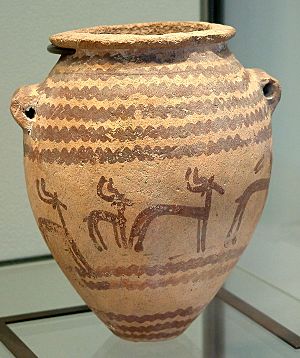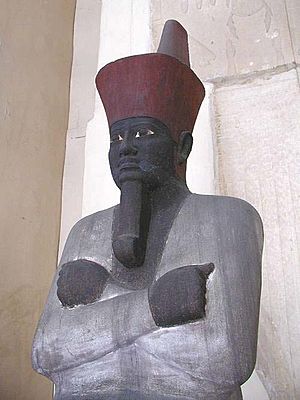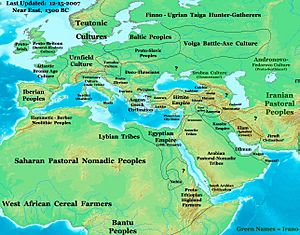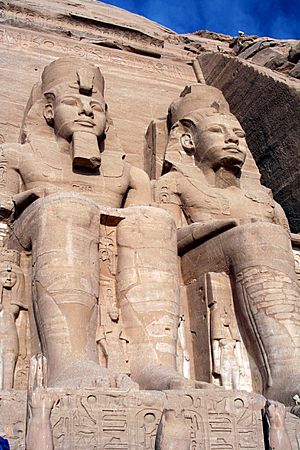History of ancient Egypt facts for kids
The history of ancient Egypt covers a long time, from early settlements in the Nile valley to the Roman conquest in 30 BC. The period when pharaohs ruled started around 3200 BC, when Upper and Lower Egypt became one country. This lasted until Macedonian rule began in 332 BC.
Contents
- Timeline of Ancient Egypt
- Early Egypt: Before the Pharaohs
- Pharaohs Rule Egypt
- Early Dynasties: Uniting the Land
- The Old Kingdom: Age of Pyramids
- First Intermediate Period: A Time of Change
- The Middle Kingdom: Reunited Egypt
- Second Intermediate Period and the Hyksos
- The New Kingdom: Egypt's Golden Age
- Third Intermediate Period: Divided Egypt
- Late Period: Foreign Rule Begins
- Persian Control
- Ptolemaic Dynasty: Greek Rulers
- Images for kids
- See also
Timeline of Ancient Egypt
Egypt's history is divided into different periods based on which dynasty of pharaohs was in charge. The exact dates for some events are still being researched. Here is a common timeline used by historians:
- Prehistoric Egypt (Before 3100 BC)
- Naqada III (also called the "protodynastic period"; about 3100–3000 BC)
- Early Dynastic Period (First–Second Dynasties)
- Old Kingdom (Third–Sixth Dynasties)
- First Intermediate Period (Seventh and Eighth–Eleventh Dynasties)
- Middle Kingdom (Twelfth–Thirteenth Dynasties)
- Second Intermediate Period (Fourteenth–Seventeenth Dynasties)
- New Kingdom (Eighteenth–Twentieth Dynasties)
- Third Intermediate Period (also known as the Libyan Period; Twenty-first–Twenty-fifth Dynasties)
- Late Period (Twenty-sixth–Thirty-first Dynasties)
Early Egypt: Before the Pharaohs
Life by the Nile River
The Nile River has always been central to Egyptian life. People started living along it during the Ice Age. We find traces of these early people, like tools and rock carvings, along the Nile and in the desert oases. For Egyptians, the Nile meant life, while the desert offered protection from invaders.
Around 12,000 BC, people along the Nile began grinding grains and using early sickles. This replaced the older way of life where people mostly hunted and fished with stone tools. There's also proof that people lived and herded cattle in southwest Egypt before 8000 BC.
Over time, the climate in North Africa changed. It became drier, eventually forming the Sahara desert by 2500 BC. This change forced early Egyptians to settle more permanently around the Nile. They had to adopt a more settled way of life.
Prehistoric Settlements
The Nile valley was hard to live in until people started clearing and watering the land along its banks. By 6000 BC, this work was well underway. At this time, Nile societies were already farming in an organized way and building large structures.
People in the Nile valley and Nile Delta grew barley and emmer (an early type of wheat). They stored their crops in pits lined with reed mats. They also raised cattle, goats, and pigs, and they wove linen and baskets.
Between 5500 BC and 3100 BC, small villages grew along the Nile, which flows into the Mediterranean Sea.
The Tasian culture appeared around 4500 BC in Upper Egypt. They are known for their "blacktop-ware" pottery, which was red and brown with a black top and inside.
The Badari culture followed the Tasian. They also made blacktop-ware, but it was better quality. The main difference is that Badari sites show signs of the Copper Age, while Tasian sites were still from the Stone Age.
The Amratian culture (also called "Naqada I") came next. They continued making blacktop-ware but also created "white cross-line ware" pottery with special patterns. During this time, trade started between Upper and Lower Egypt. They imported copper from the Sinai Peninsula or Nubia, and gold and obsidian from Nubia.
The Gerzeh culture ("Naqada II") was a very important step in Egyptian development. It started in the Nile Delta and moved south. During this time, rainfall decreased, so farming became even more important. People settled down more, and larger villages grew into cities with about 5000 residents. They began using adobe bricks to build their cities. Copper was used more often for tools and weapons instead of stone. People also used silver, gold, lapis lazuli, and Egyptian faience for decorations.
By 3300 BC, just before the first pharaohs, Egypt was split into two kingdoms: Upper Egypt in the south and Lower Egypt in the north. The dividing line was near where modern Cairo is today.
Pharaohs Rule Egypt
Early Dynasties: Uniting the Land
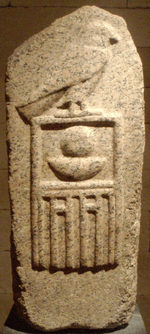
Ancient Egypt became a single, unified country around 3150 BC. Egyptian stories say that a king named Menes brought Upper and Lower Egypt together. For almost 3000 years, Egyptian culture, art, buildings, and social structure stayed very similar, and they were all closely connected to their religion.
Historians often divide the history of pharaohs into periods based on a list made by an ancient writer named Manetho. Before Egypt was united, it was made up of many independent villages. After unification, the country was known as the "Two Lands." The pharaohs set up a national government and appointed governors.
While Manetho said Menes was the first pharaoh, archaeological finds suggest that Narmer was the first ruler to unite the two lands. His name is famous from the Narmer Palette, which shows him uniting Upper and Lower Egypt. Menes is now thought to be one of the titles for Hor-Aha, the second pharaoh of the First Dynasty.
Early pharaohs and important people were buried in mastabas, which were flat-topped, rectangular tombs. These later became the models for the first pyramids, like the step pyramid, built during the Third Dynasty of Egypt.
The Old Kingdom: Age of Pyramids
The Old Kingdom lasted from about 2686 to 2181 BC, covering the Third through Sixth Dynasties. The capital city was Memphis.
This period is famous for the many pyramids built as burial places for pharaohs. That's why it's often called "the Age of the Pyramids." The first important pharaoh of the Old Kingdom was Djoser of the Third Dynasty. He ordered the building of the first pyramid, the Pyramid of Djoser, in Saqqara.
During this time, independent states became "nomes" (districts) ruled only by the pharaoh. Local rulers became "nomarchs" (governors) or tax collectors. Egyptians believed the pharaoh was a god who made sure the Nile flooded every year, which was vital for their crops.
The Old Kingdom was strongest under the Fourth Dynasty. Sneferu, the first king of this dynasty, built at least three pyramids. His son, Khufu, built the Great Pyramid of Giza. Khufu, his son Khafre, and grandson Menkaure are all famous for building the Giza pyramid complex.
Building these huge pyramids needed a strong, central government. Recent digs near the pyramids show a large city that housed and fed the workers. It was once thought that slaves built these monuments, but studies show they were built by Egyptian peasants. They worked when their fields were flooded, along with skilled workers like stonecutters and artists.
The Fifth Dynasty began around 2495 BC with Userkaf. During this time, the worship of the sun god Ra became more important. Less effort went into building pyramids and more into building sun temples. The last king of this dynasty, Unas, was the first to have special religious texts, called the Pyramid Texts, written inside his pyramid.
Egypt also started trading more for goods like ebony, myrrh, frankincense, gold, and copper. They traded with the Syrian coast for cedar wood and sent expeditions to the faraway Land of Punt (possibly in the Horn of Africa).
During the Sixth Dynasty (2345–2181 BC), the pharaohs' power slowly weakened. Powerful nomarchs became more independent. Internal problems grew during the very long reign of Pepi II Neferkare. His death likely led to struggles for power. The Old Kingdom finally collapsed due to civil wars and a major climate change around 2200 BC, which caused low Nile floods and famine.
First Intermediate Period: A Time of Change
After the Old Kingdom fell, Egypt went through about 200 years of disarray, known as the First Intermediate Period. During this time, many local rulers likely held power in their own areas. Ancient texts from the later Middle Kingdom, called "Lamentations," describe this period as a time when society and nature seemed to be turned upside down.
It's also believed that during this time, many pyramids and tombs were robbed. Later, mummies were decorated with magical spells that used to be only for the kings' pyramids.
By 2160 BC, new pharaohs from the Ninth and Tenth Dynasties took control of Lower Egypt from their capital in Heracleopolis Magna. At the same time, a rival group, the Eleventh Dynasty, based in Thebes, reunited Upper Egypt. A conflict between them was unavoidable. Around 2055 BC, the Theban forces defeated the Heracleopolitan pharaohs and reunited Egypt. The reign of their first pharaoh, Mentuhotep II, marked the start of the Middle Kingdom.
The Middle Kingdom: Reunited Egypt
The Middle Kingdom lasted from about 2030 to 1650 BC. It includes the Eleventh Dynasty, which ruled from Thebes, and the Twelfth Dynasty, whose capital was Lisht.
The earliest pharaohs of the Middle Kingdom came from Thebes. Intef I was the first Theban ruler to claim the throne of Egypt. This led to fighting with the Tenth Dynasty rulers.
The Theban dynasty finally took control of all Egypt during the 39th year of Mentuhotep II's reign. Mentuhotep II also led military campaigns into Nubia and the Southern Levant. He reorganized the country and put a vizier (a high official) in charge of the government.
Mentuhotep II's son, Mentuhotep III, sent an expedition to Punt. His reign saw some of the most beautiful Egyptian carvings. The last pharaoh of this dynasty was Mentuhotep IV. His vizier, Amenemhat I, is believed to have become the first pharaoh of the Twelfth Dynasty.
Amenemhat I built a new capital called Itjtawy, near modern-day Lisht. He stopped internal unrest and reduced the power of the nomarchs. He also launched campaigns into Nubia. His son, Senusret I, continued his father's policies to regain territories lost during the First Intermediate Period. Egypt became prosperous and secure under his long reign.
Senusret III (1878–1839 BC) was a strong warrior king. He led his troops deep into Nubia and built many large forts to mark Egypt's borders. Amenemhat III (1860–1815 BC) is considered the last great pharaoh of the Middle Kingdom.
During Amenemhat III's reign, Egypt's population grew too large for its food supply. He ordered more farming in the Faiyum region and increased mining in the Sinai Peninsula. He also invited settlers from Western Asia to work on Egypt's buildings. Later in his reign, the Nile floods became lower, putting more strain on the government. The Thirteenth and Fourteenth Dynasties saw Egypt slowly decline into the Second Intermediate Period. Some of the settlers invited by Amenemhat III would later take power as the Hyksos.
Second Intermediate Period and the Hyksos
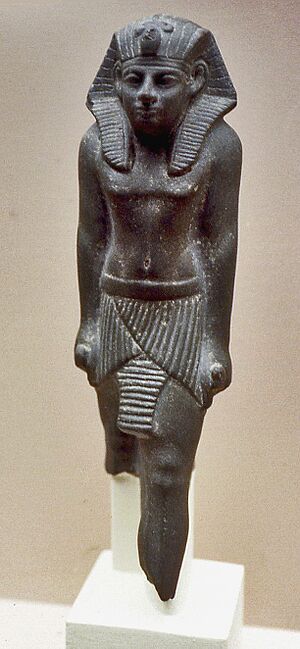
The Second Intermediate Period was a time when Egypt was again in disarray, between the Middle Kingdom and the New Kingdom. This period is known for the arrival of the Hyksos, whose kings formed the Fifteenth Dynasty.
The Thirteenth Dynasty could not hold onto all of Egypt. A family from the Levant, living in the eastern Delta at Avaris, broke away to form the Fourteenth Dynasty.
The Hyksos first appeared around 1650 BC. They took control of Avaris and quickly moved south to Memphis, ending the Thirteenth and Fourteenth Dynasties. Some historians believe the Hyksos "invaded" Egypt, while others think it was a more peaceful migration. Either way, the weakened Egyptian kingdoms could not stop them.
The Hyksos princes ruled in the eastern Delta with local Egyptian leaders. Their capital was Memphis, and their summer home was Avaris.
The Hyksos kingdom expanded south. Around the time Memphis fell, the native Egyptian rulers in Thebes declared their independence and formed the Sixteenth Dynasty.
By 1600 BC, the Hyksos had moved further south, threatening the Sixteenth Dynasty. Thebes fell to the Hyksos for a short time around 1580 BC. However, the Hyksos soon pulled back north, and Thebes regained some independence under the Seventeenth Dynasty.
The Seventeenth Dynasty eventually led a war to free Egypt from the Hyksos. Its last two kings were Seqenenre Tao and Kamose. Ahmose I completed the fight, driving the Hyksos out of the Nile Delta. He reunited Egypt and brought back Egyptian power in Nubia and the Southern Levant. His reign marks the beginning of the Eighteenth Dynasty and the New Kingdom.
The New Kingdom: Egypt's Golden Age
Because of the foreign rule of the Hyksos, the New Kingdom saw Egypt try to create a protective zone between itself and the Levant. Egypt reached its largest size during this time, expanding far south into Nubia and holding large areas in the Near East. Egyptian armies even fought Hittite armies for control of modern-day Syria.
Eighteenth Dynasty: Powerful Pharaohs
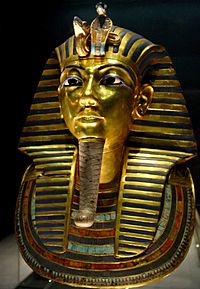
This was a time of great wealth and power for Egypt. Some of the most famous pharaohs ruled during this period. Hatshepsut was a female pharaoh, which was very rare in Egyptian history. She was a strong and capable leader. She expanded Egyptian trade south into modern-day Somalia and north into the Mediterranean Sea. She ruled for twenty years using clever political skills. Her co-ruler and successor, Thutmose III, built up Egypt's army and used it very successfully. He fought against people from Asia and was one of Egypt's most successful pharaohs. Amenhotep III built many parts of the Karnak temple, including the Luxor Temple.
Nineteenth Dynasty: Ramesses the Great
Ramesses I ruled for two years, followed by his son Seti I. Seti I worked to bring back Egypt's power and respect. He also built the temple complex at Abydos.
Ancient Egypt's power as a nation was probably at its highest during the reign of Ramesses II ("the Great") of the Nineteenth Dynasty. He ruled for 67 years, starting at age 18. He continued his father's work and built many magnificent temples, like the Abu Simbel temples near the Nubian border. He tried to get back lands in the Levant that the Eighteenth Dynasty had held. His military campaigns led to the Battle of Kadesh in 1274 BC, where he led Egyptian armies against the Hittite king Muwatalli II. This battle is famous for being the first recorded military ambush in history.
Ramesses II was known for having many children with his wives and concubines. The tomb he built for his sons in the Valley of the Kings is the largest tomb complex in Egypt.
His sons who followed him continued the military campaigns, but the royal court became more troubled. After Ramesses II, his son Merneptah ruled, then Merneptah's son Seti II. Seti II's rule was challenged by his half-brother Amenmesse.
After Seti II died, his son Siptah became pharaoh, guided by a foreign official named Chancellor Bay. When Siptah died young, Twosret, Seti II's queen, took the throne. After Twosret's short reign, a period of chaos led to the execution of Bay and the rise of Setnakhte, who started the Twentieth Dynasty.
Twentieth Dynasty: Challenges and Decline
The last "great" pharaoh of the New Kingdom is usually considered Ramesses III, son of Setnakhte. He ruled three decades after Ramesses II. In his eighth year, the Sea People invaded Egypt by land and sea. Ramesses III defeated them in two major battles. He claimed he settled them in Southern Canaan, but there is also evidence they forced their way in. Their presence in Canaan may have helped new states like Philistia form after the Egyptian Empire declined. He also fought invading Libyan tribes in the Western Delta.
The high cost of these battles slowly drained Egypt's treasury and led to the gradual decline of the Egyptian Empire in Asia. These problems were so severe that the first known strike action in history happened in Ramesses III's 29th year. The food for the royal tomb-builders in Deir el-Medina could not be provided. Something in the air also blocked sunlight, affecting global tree growth for almost two decades.
After Ramesses III died, there were many arguments among his sons. Three of them became pharaohs: Ramesses IV, Ramesses VI, and Ramesses VIII. However, Egypt was also facing droughts, low Nile floods, famine, civil unrest, and corruption. The last pharaoh, Ramesses XI, became so weak that the Theban High Priests of Amun became the real rulers of Upper Egypt, while Smendes controlled Lower Egypt. Smendes later founded the Twenty-first Dynasty at Tanis.
Third Intermediate Period: Divided Egypt
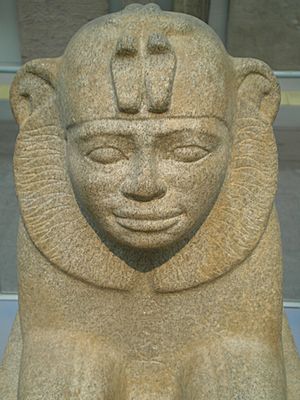
After Ramesses XI died, his successor Smendes ruled from Tanis in the north. Meanwhile, the High Priests of Amun at Thebes effectively ruled the south, though they still recognized Smendes as king. This division wasn't as big a problem as it sounds, because both the priests and pharaohs came from the same family. The country was split into two parts, with the priests in Thebes and the pharaohs at Tanis.
These rulers were later replaced by Libyan kings of the Twenty-Second Dynasty without much struggle. Egypt had long-standing connections with Libya. The first king of this new dynasty, Shoshenq I, was a Libyan who had been an army commander. He reunited the country and put his own son in charge of the Amun priests, a position that used to be passed down through families.
After the reign of Osorkon II, the country split again into two states. Shoshenq III of the Twenty-Second Dynasty controlled Lower Egypt, while Takelot II and his son ruled Middle and Upper Egypt.
After Egypt pulled back from Nubia at the end of the New Kingdom, a local dynasty took control of Nubia. Under King Piye, the Nubian founder of the Twenty-Fifth Dynasty, the Nubians moved north to defeat the Libyan rulers in the Delta. Piye gained power as far as Memphis. His opponent Tefnakhte eventually gave in but was allowed to keep power in Lower Egypt, founding the short-lived Twenty-Fourth Dynasty. The Kushite kingdom from the south took advantage of Egypt's division. Piye established the Nubian Twenty-Fifth Dynasty and made the defeated rulers his governors. He was followed by his brother, Shabaka, and then his two sons, Shebitku and Taharqa.
Taharqa reunited the "Two Lands" of Northern and Southern Egypt and created an empire as large as it had been since the New Kingdom. The 25th dynasty brought a rebirth for Ancient Egypt. Religion, art, and architecture were restored to their glorious forms from the Old, Middle, and New Kingdoms. Pharaohs like Taharqa built or restored temples and monuments throughout the Nile valley. It was during the 25th dynasty that the Nile valley saw the first widespread building of pyramids (many in modern Sudan) since the Middle Kingdom.
Egypt's international standing declined during this time. Its allies came under the influence of Assyria. From about 700 BC, it was clear that war between the two states was coming. Taharqa's reign and that of his successor, Tanutamun, were filled with constant fighting against the Assyrians. Despite some victories, Thebes was eventually occupied, and Memphis was sacked.
Late Period: Foreign Rule Begins
From 671 BC onwards, Memphis and the Delta region were attacked many times by the Assyrians. They drove out the Nubians and gave power to kings of the Twenty-Sixth Dynasty. Psamtik I was the first king recognized as ruling all of Egypt. He brought more stability to the country during his 54-year reign from the new capital of Sais. Four Saite kings after him ruled Egypt successfully and peacefully from 610–526 BC. They kept the Babylonians away with the help of Greek soldiers.
However, the Babylonian emperor Nebuchadnezzar II fought against the Egyptians and pushed them back over the Sinai. In 567 BC, he went to war with Pharaoh Amasis II and briefly invaded Egypt.
By the end of this period, a new power was growing in the Near East: Persia. The pharaoh Psamtik III had to face the powerful Persian army at Pelusium. He was defeated and captured, then later executed.
Persian Control
Persian rule in Egypt can be divided into three parts: the first period when Egypt became a Persian province, then a time of independence, and finally, the second and last period of Persian rule.
The Persian king Cambyses took the title of Pharaoh and honored the Egyptian gods. He founded the Twenty-seventh dynasty. Egypt was then joined with Cyprus and Phoenicia as part of the Persian Empire.
Cambyses' successors, Darius I the Great and Xerxes, followed similar policies. They visited Egypt and fought off an attack from Athens. Even though these kings visited, Egyptians were not happy with Persian rule.
During a war for power after Darius II's reign, the Egyptians revolted under Amyrtaeus in 404 BC and regained their independence. This ruler of the Twenty-eighth dynasty died in 399 BC, and power went to the Twenty-ninth dynasty. The Thirtieth Dynasty was established in 380 BC and lasted until 343 BC. Nectanebo II was the last native Egyptian king to rule Egypt.
Artaxerxes III (358–338 BC) reconquered the Nile valley for a short time (343–332 BC). In 332 BC, Mazaces handed Egypt over to Alexander the Great without a fight. The Persian Empire had ended, and Egypt became a province in Alexander's empire. Later, the Ptolemies and then the Romans would rule the Nile valley.
Ptolemaic Dynasty: Greek Rulers
In 332 BC, Alexander the Great of Macedon conquered Egypt easily from the Persians. Egyptians welcomed him as a liberator. He visited Memphis and went to the oracle of Amun at the Oasis of Siwa, where he was declared the son of Amun. He showed respect for Egyptian religion but put Greeks in almost all the important positions. He founded a new Greek city, Alexandria, to be the new capital. Egypt's wealth could now be used for Alexander's conquests. In 331 BC, he left Egypt and never returned.
After Alexander's death in Babylon in 323 BC, his generals fought over who would rule his empire. Ptolemy, one of Alexander's closest friends, was appointed governor of Egypt. Ptolemy ruled Egypt from 323 BC, even though he was technically ruling for Alexander's half-brother and infant son. As Alexander's empire broke apart, Ptolemy soon became ruler in his own right. He successfully defended Egypt against an invasion in 321 BC. In 305 BC, Ptolemy took the title of King. He founded the Ptolemaic dynasty that ruled Egypt for almost 300 years.
Later Ptolemaic rulers adopted Egyptian traditions, like marrying their siblings. They were shown on public monuments in Egyptian style and clothing, and they took part in Egyptian religious life. Greek culture continued to thrive in Egypt even after the Muslim conquest. The Ptolemies had to fight local rebellions and were involved in foreign and civil wars, which led to their kingdom's decline and its takeover by Rome.
Images for kids
-
A Mesopotamian king shown as the Master of Animals on the Gebel el-Arak Knife. This knife is from the Naqada II period (around 3300-3200 BC) and was found in Abydos, Egypt. It shows how Mesopotamia influenced Egypt very early on.
-
A portrait of the "Black Pharaoh" Taharqa, at the Kerma Museum.
-
An Egyptian soldier from the Persian army, around 470 BC. From a relief on Xerxes I's tomb.
-
A ring with an engraved portrait of Ptolemy VI Philometor as Pharaoh (3rd–2nd century BC). At the Louvre Museum.
See also
 In Spanish: Historia del antiguo Egipto para niños
In Spanish: Historia del antiguo Egipto para niños


